

In the 1920s, 46 Colorado mountains were considered to be 14ers. In the early 70s there were 53; today there are 54 by most people's count. Some people argue that there are 56. Others are still stuck with 53 (but a different 53 from those in the 70s). What's going on?
Ideally, there should be some objective criteria on which to base a mountain's status. For the most part, there are. A peak is now considered to be a 14er if the summit meets both of the following criteria:
 In practice these criteria disqualify mountains such as Mt.
Cameron in the Mosquito range. Its 14,238 feet elevation places
it among Colorado's 20 highest mountains, but the saddle that
connects it to nearby Mt. Lincoln (14,286 feet) is but 138 feet
below Lincoln's summit. (It sure seems like more to us -
see photo of Mt. Lincoln on the left which is taken from the
saddle). According to the rules, Mt. Cameron is
part of Mt. Lincoln, not its own official mountain.
In practice these criteria disqualify mountains such as Mt.
Cameron in the Mosquito range. Its 14,238 feet elevation places
it among Colorado's 20 highest mountains, but the saddle that
connects it to nearby Mt. Lincoln (14,286 feet) is but 138 feet
below Lincoln's summit. (It sure seems like more to us -
see photo of Mt. Lincoln on the left which is taken from the
saddle). According to the rules, Mt. Cameron is
part of Mt. Lincoln, not its own official mountain.
In short, as long as there are two summits above 14,000 feet and at least a 300 foot drop between them, you've got two 14ers. Less than 300 feet... you've got one mountain.
If only it were that simple!
The vast majority of 14ers were designated before these criteria were adopted by the Colorado Mountain Club and the US Geological Survey. Because of that, there are today a couple of mountains which are considered 14ers but do not meet the criteria. These are North Maroon Peak and El Diente. Why are these still considered 14ers even though they don't fit the criteria? Tradition! And, especially for North Maroon, there would be quite a controversy if someone tried to remove its 14er status. After Pikes Peak, North Maroon and its neighbor, Maroon Peak, are probably Colorado's most famous mountains. The saddle between Maroon and North Maroon, though, is only 234 feet below the summit of the higher mountain.
Speaking of controveries, there is the case of Challenger Point. At 14,081 feet with a connecting saddle which is 301 feet below its neighbor, Kit Carson Peak (14,165 feet), it qualifies as a 14er by the criteria above. Many people, though, don't feel it should be considered as its own mountain, since the summits of the two are but one-fifth of a mile apart. So, apparently, it's got to look and feel like a 14er, too!
Hike To Democrat, Lincoln and Bross